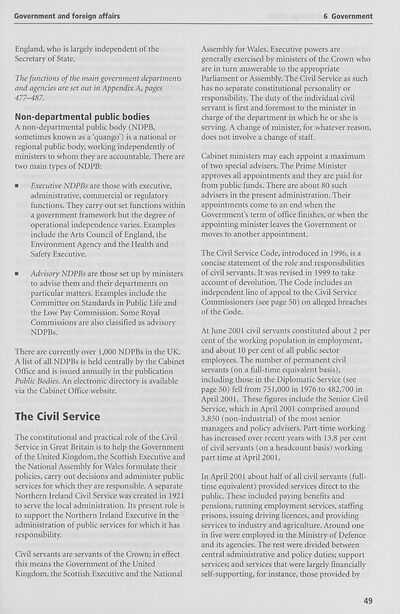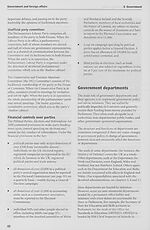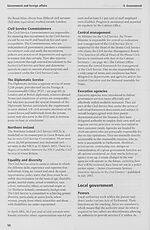Download files
Complete book:
Individual page:
Thumbnail gallery: Grid view | List view

Government and foreign affairs
6 Government
England, who is largely independent of the
Secretary of State.
The functions of the main government departments
and agencies are set out in Appendix A, pages
477-487.
Non-departmental public bodies
A non-departmental public body (NDPB,
sometimes known as a ‘quango’) is a national or
regional public body, working independently of
ministers to whom they are accountable. There are
two main types of NDPB:
■ Executive NDPBs are those with executive,
administrative, commercial or regulatory
functions. They carry out set functions within
a government framework but the degree of
operational independence varies. Examples
include the Arts Council of England, the
Environment Agency and the Health and
Safety Executive.
■ Advisory NDPBs are those set up by ministers
to advise them and their departments on
particular matters. Examples include the
Committee on Standards in Public Life and
the Low Pay Commission. Some Royal
Commissions are also classified as advisory
NDPBs.
There are currently over 1,000 NDPBs in the UK.
A list of all NDPBs is held centrally by the Cabinet
Office and is issued annually in the publication
Public Bodies. An electronic directory is available
via the Cabinet Office website.
The Civil Service
The constitutional and practical role of the Civil
Service in Great Britain is to help the Government
of the United Kingdom, the Scottish Executive and
the National Assembly for Wales formulate their
policies, carry out decisions and administer public
services for which they are responsible. A separate
Northern Ireland Civil Service was created in 1921
to serve the local administration. Its present role is
to support the Northern Ireland Executive in the
administration of public services for which it has
responsibility.
Civil servants are servants of the Crown; in effect
this means the Government of the United
Kingdom, the Scottish Executive and the National
Assembly for Wales. Executive powers are
generally exercised by ministers of the Crown who
are in turn answerable to the appropriate
Parliament or Assembly. The Civil Service as such
has no separate constitutional personality or
responsibility. The duty of the individual civil
servant is first and foremost to the minister in
charge of the department in which he or she is
serving. A change of minister, for whatever reason,
does not involve a change of staff.
Cabinet ministers may each appoint a maximum
of two special advisers. The Prime Minister
approves all appointments and they are paid for
from public funds. There are about 80 such
advisers in the present administration. Their
appointments come to an end when the
Government’s term of office finishes, or when the
appointing minister leaves the Government or
moves to another appointment.
The Civil Service Code, introduced in 1996, is a
concise statement of the role and responsibilities
of civil servants. It was revised in 1999 to take
account of devolution. The Code includes an
independent line of appeal to the Civil Service
Commissioners (see page 50) on alleged breaches
of the Code.
At June 2001 civil servants constituted about 2 per
cent of the working population in employment,
and about 10 per cent of all public sector
employees. The number of permanent civil
servants (on a full-time equivalent basis),
including those in the Diplomatic Service (see
page 50) fell from 751,000 in 1976 to 482,700 in
April 2001. These figures include the Senior Civil
Service, which in April 2001 comprised around
3,850 (non-industrial) of the most senior
managers and policy advisers. Part-time working
has increased over recent years with 13.8 per cent
of civil servants (on a headcount basis) working
part time at April 2001.
In April 2001 about half of all civil servants (full¬
time equivalent) provided services direct to the
public. These included paying benefits and
pensions, running employment services, staffing
prisons, issuing driving licences, and providing
services to industry and agriculture. Around one
in five were employed in the Ministry of Defence
and its agencies. The rest were divided between
central administrative and policy duties; support
services; and services that were largely financially
self-supporting, for instance, those provided by
49
6 Government
England, who is largely independent of the
Secretary of State.
The functions of the main government departments
and agencies are set out in Appendix A, pages
477-487.
Non-departmental public bodies
A non-departmental public body (NDPB,
sometimes known as a ‘quango’) is a national or
regional public body, working independently of
ministers to whom they are accountable. There are
two main types of NDPB:
■ Executive NDPBs are those with executive,
administrative, commercial or regulatory
functions. They carry out set functions within
a government framework but the degree of
operational independence varies. Examples
include the Arts Council of England, the
Environment Agency and the Health and
Safety Executive.
■ Advisory NDPBs are those set up by ministers
to advise them and their departments on
particular matters. Examples include the
Committee on Standards in Public Life and
the Low Pay Commission. Some Royal
Commissions are also classified as advisory
NDPBs.
There are currently over 1,000 NDPBs in the UK.
A list of all NDPBs is held centrally by the Cabinet
Office and is issued annually in the publication
Public Bodies. An electronic directory is available
via the Cabinet Office website.
The Civil Service
The constitutional and practical role of the Civil
Service in Great Britain is to help the Government
of the United Kingdom, the Scottish Executive and
the National Assembly for Wales formulate their
policies, carry out decisions and administer public
services for which they are responsible. A separate
Northern Ireland Civil Service was created in 1921
to serve the local administration. Its present role is
to support the Northern Ireland Executive in the
administration of public services for which it has
responsibility.
Civil servants are servants of the Crown; in effect
this means the Government of the United
Kingdom, the Scottish Executive and the National
Assembly for Wales. Executive powers are
generally exercised by ministers of the Crown who
are in turn answerable to the appropriate
Parliament or Assembly. The Civil Service as such
has no separate constitutional personality or
responsibility. The duty of the individual civil
servant is first and foremost to the minister in
charge of the department in which he or she is
serving. A change of minister, for whatever reason,
does not involve a change of staff.
Cabinet ministers may each appoint a maximum
of two special advisers. The Prime Minister
approves all appointments and they are paid for
from public funds. There are about 80 such
advisers in the present administration. Their
appointments come to an end when the
Government’s term of office finishes, or when the
appointing minister leaves the Government or
moves to another appointment.
The Civil Service Code, introduced in 1996, is a
concise statement of the role and responsibilities
of civil servants. It was revised in 1999 to take
account of devolution. The Code includes an
independent line of appeal to the Civil Service
Commissioners (see page 50) on alleged breaches
of the Code.
At June 2001 civil servants constituted about 2 per
cent of the working population in employment,
and about 10 per cent of all public sector
employees. The number of permanent civil
servants (on a full-time equivalent basis),
including those in the Diplomatic Service (see
page 50) fell from 751,000 in 1976 to 482,700 in
April 2001. These figures include the Senior Civil
Service, which in April 2001 comprised around
3,850 (non-industrial) of the most senior
managers and policy advisers. Part-time working
has increased over recent years with 13.8 per cent
of civil servants (on a headcount basis) working
part time at April 2001.
In April 2001 about half of all civil servants (full¬
time equivalent) provided services direct to the
public. These included paying benefits and
pensions, running employment services, staffing
prisons, issuing driving licences, and providing
services to industry and agriculture. Around one
in five were employed in the Ministry of Defence
and its agencies. The rest were divided between
central administrative and policy duties; support
services; and services that were largely financially
self-supporting, for instance, those provided by
49
Set display mode to:
![]() Universal Viewer |
Universal Viewer | ![]() Mirador |
Large image | Transcription
Mirador |
Large image | Transcription
The item on this page appears courtesy of Office for National Statistics and may be re-used under the Open Government Licence for Public Sector Information.
| Britain and UK handbooks > UK: The official yearbook of the United Kingdom of Great Britain and Northern Ireland > 2003 > (71) |
|---|
| Permanent URL | https://digital.nls.uk/204924030 |
|---|
| Attribution and copyright: |
|
|---|---|
| Description | Three volumes of 'UK: The official yearbook of the United Kingdom of Great Britain and Northern Ireland', published annually by the Office of National Statistics from 2002-2005. |
|---|---|
| Shelfmark | GII.11 SER |
| Description | Three titles produced by the British Government from 1954-2005 describing 'how Britain worked'. They are: 'Britain: An official handbook' (1954-1998), 'Britain: The official yearbook of the United Kingdom' (1999-2001), and 'UK: The official yearbook of the United Kingdom of Great Britain and Northern Ireland' (2002-2005). These 50 reports provide an overview of Britain's economic, social and cultural affairs, its environment, international relations, and the systems of government. They give an impartial summary of government policies and initiatives, and explain how public services are organised. |
|---|---|
| Additional NLS resources: |
|

